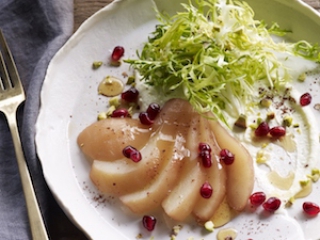
Lesson Plan: Evaluating Various Fruit Product Formats
01 March 2017Teach students how to evaluate different fruit product formats including fresh cut, frozen and canned for menu development.
The drumbeat for eating more fresh fruit has never been louder and consumer awareness of the role that fruit plays on the menu, beyond the fruit cup, has never been greater. In restaurant kitchens fresh whole fruit isn’t always the best choice to achieve the desired outcome of a dish or operational efficiency in the kitchen. Using processed fruits can help manage prep time and control food waste while adding a fresh taste to the dishes’ flavor.
Include these objectives in your fruit format lesson plan:
- Maximize use of different fruit product formats available for year-round menu development – fresh, fresh cut, frozen, canned, dried, juice and puree.
- Understand how different formats can reduce waste in the foodservice kitchen.
- Improve the quality, variety and appeal of fruit used in foodservice.
There is virtually no food waste in the manufacturing of processed fruit formats because logistics are efficiently managed in the field and at the processing plant. Waste is also minimized when processors use produce in formats other than fresh or fresh cut, where the fruit is less than picture-perfect but otherwise as delicious and nutritious.
Fresh-cut produce is typically available halved, diced, cubed, sliced and planked. These products can save labor and provide consistency. For fruits like fresh mango, ripening is carefully managed before cutting to achieve the best eating quality. Many operators choose fresh-cut produce for the texture and flavor that it brings to a recipe, as well as following through on their commitment to using fresh ingredients.
Ironically, frozen and canned fruit can frequently taste fresher and the nutrient content is comparable or better than fresh. It pays to taste as well as look beyond the label at frozen and canned fruits.
For example, red raspberries grown for freezing are harvested at the peak of ripeness and are typically frozen close to where the fruit is grown. Processors often use Individual Quick Freezing technology to preserve the taste and aroma and to keep the individual berries and berry pieces separated for easy portioning. The only thing added in the process is cold air. Chefs probably wouldn’t use frozen raspberries as a garnish or where fruit integrity is essential, but sweet and savory applications like sauces/dressings, fillings, toppings/condiments, baked goods and beverages could benefit from the use of frozen fruit.
For canned fruits, such as Bartlett pears that require ripening off the tree, the fruit is harvested when it’s mature. Pears are then carefully ripened by canners before canning. The result is a poached pear that is ripe and ready to use. Canning is a time-honored process, invented in 1810, and some chefs use this method to preserve their own crops for use at a later time. Canned halves, sliced and diced pears save labor, are easy to store and provide more versatility. Fan canned pear halves for salads and pastries or, for signature appeal, use cold poached pears in pomegranate juice. Chefs also stir diced pears into baked goods and condiments like fresh chutney and other flavorful condiments.
Year-round use of fruit on menus continues to grow and consumers often try fruit in new ways at restaurants. Restaurant customers look forward to seasonal menus, but new research from Mintel (Seasonal Dining Trends US 2017) revealed that nearly seven in 10 or 67 percent of consumers like being able to enjoy seasonal ingredients that they find nostalgic year-round.
Evaluating Fruit Formats
Use this chart to evaluate different formats of one or more fruit varieties. Instructors can set up the activity as one large group or break students into small groups each with a different fruit. After students have evaluated the fruit’s sensory characteristics of look, flavor and texture, instructors can discuss different menu applications for each format.
|
Fruit |
Format |
Flavor |
Texture |
Applications |
|
|
|
|
|
|
|
|
|
|
|
|
|
|
|
|
|
|
Lesson Plan courtesy of Susan Hughes, a foodservice marketing consultant with a specialization in the produce industry.
Photo of Persian Pear Plate courtesy of Pacific Northwest Canned Pear Service.
